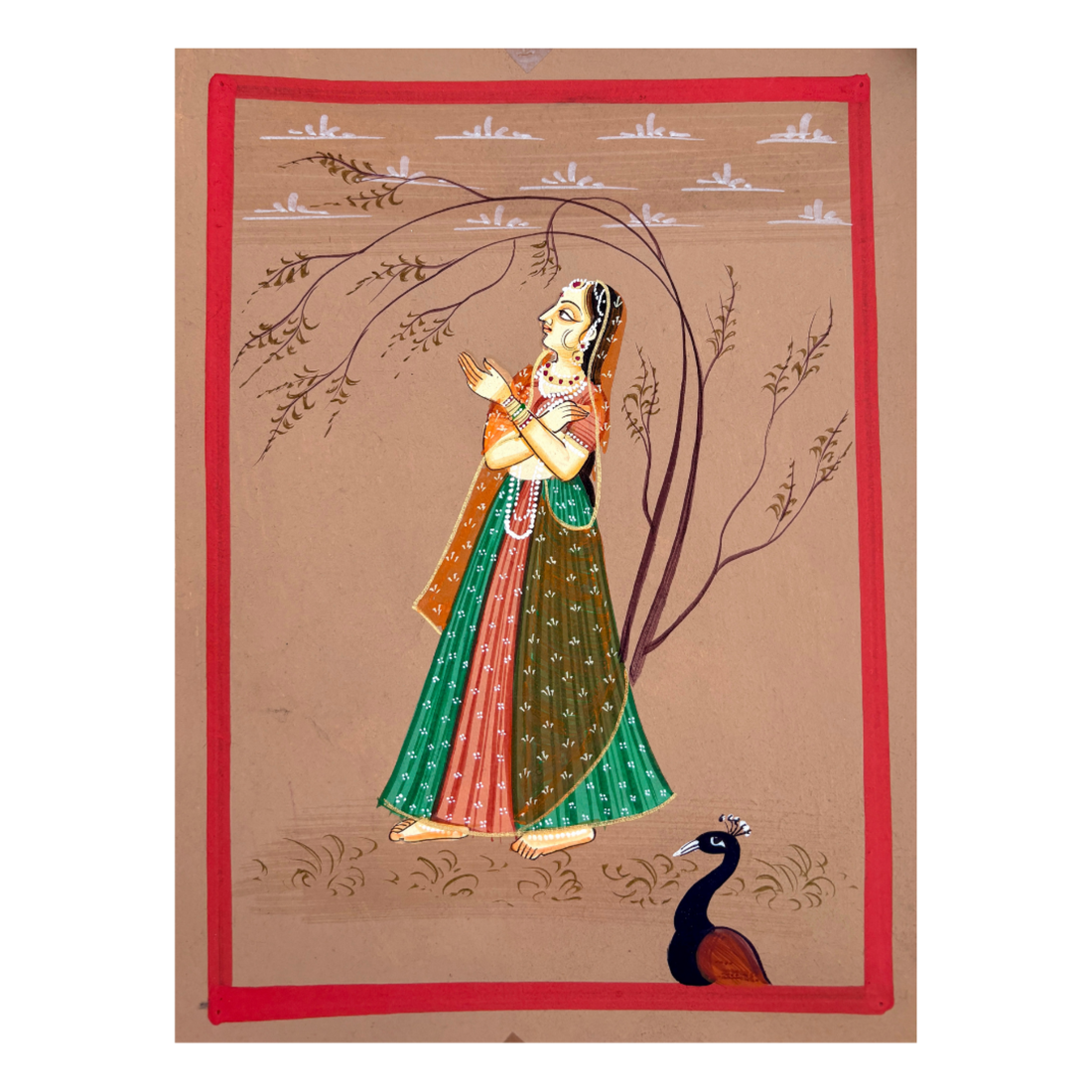
Traditional Art of Rajasthan: Exploring Rajasthani Folk Art and Painting Styles
Share
Why the Traditional Art of Rajasthan Still Captivates Us
Rajasthan, known as the "Land of Kings," is not just famous for its forts and palaces but also for its deep-rooted cultural heritage. Among its many cultural treasures, the traditional art of Rajasthan continues to hold a special place in the hearts of art lovers and historians across the world. Passed down through generations, this art reflects the stories, rituals, and vibrant life of the people of Rajasthan.
The traditional art of Rajasthan plays a key role in showcasing the region’s history, mythology, and values. Whether it’s wall paintings in village homes or miniature art from royal courts, each artwork tells a story filled with emotion and symbolism. Bright colours, intricate details, and meaningful patterns are the true identity of this artistic legacy.
This blog takes you on a journey to explore both Rajasthani folk art and painting styles, shedding light on their evolution, regional variations, and present-day relevance. From the spiritual expressions of Mandana to the graceful strokes of the Kishangarh style, Rajasthan’s traditional art is not just a visual treat—it’s a cultural experience. Let’s dive deeper into the world where every brushstroke speaks of a timeless tradition.
What Makes Rajasthan Folk Art Unique in Indian Culture?
Rajasthan folk art is a vibrant expression of the state's rich traditions, beliefs, and daily life. Unlike classical art, which often follows formal training and fixed rules, folk art is created by local artisans and villagers who learn through observation and practice. It is deeply rooted in the customs of the community and reflects their way of life.
What sets Rajasthan folk art apart is its strong connection to festivals, rituals, and folklore. Art forms like Mandana, Pichwai, Phad, and Kaavad are not just decorative—they tell stories of gods, goddesses, and heroic legends. These artworks are often created on walls, cloth, wood, and clay, using natural materials like red ochre, chalk, charcoal, and plant-based colours.
Each region in Rajasthan adds its own local touch to folk art, influenced by the desert landscape, traditional attire, and local customs. Bright colours, bold lines, and symbolic motifs like peacocks, elephants, and lotuses are commonly seen. The cultural meanings behind these elements give the art emotional depth and spiritual value.
This unique blend of storytelling, tradition, and regional style makes Rajasthan folk art a standout in Indian culture—celebrated both within the state and beyond its borders.
Which Are the Most Popular Rajasthani Folk Art Forms?
Rajasthani folk art is known for its diversity, beauty, and deep cultural meaning. Over centuries, different communities across Rajasthan have developed unique art forms, each with its own story and style. Some of the most famous art forms of Rajasthan are still alive today, practised by local artists in villages and towns, and admired across the world.
One such art form of Rajasthan is Mandana, a traditional floor and wall painting made during festivals and special occasions. Women in rural Rajasthan draw Mandana patterns using lime and red clay, believed to invite divine blessings into the home.
Another beautiful style is Sanjhi, a delicate stencil-based art using paper cutouts to create detailed images of Radha and Krishna. Though it started in other parts of India, Sanjhi has found a unique voice in Rajasthan’s temples.
Pichwai paintings are devotional artworks made on cloth, mainly seen in Nathdwara. These vibrant paintings illustrate stories of Lord Krishna and are often used as temple backdrops.
Kaavad is a storytelling tradition where wooden boxes are painted with mythological tales. Storytellers travel from village to village, opening each panel as they narrate the stories inside.
These timeless Rajasthani folk art forms keep traditions alive and continue to enchant new generations.
How Did Rajasthani Art Painting Evolve Over Time?
Rajasthani art painting has a long and colourful history, deeply connected to the region's royal heritage and spiritual traditions. It began around the 16th century and grew over time through the patronage of Rajput rulers, who encouraged local artists to express stories of bravery, devotion, and nature through their art.
In the early days, Rajasthani art painting was inspired by religious texts, especially the Ramayana and Mahabharata. These stories were illustrated in bold colours and fine details on walls, palm leaves, and later, handmade paper. The themes were mostly spiritual, often showing scenes of gods, festivals, and village life.
As time passed, the Rajput courts began shaping the painting styles in their regions—each kingdom developed a distinct school of art like Mewar, Marwar, Bundi, and Kishangarh. These styles used strong lines, bright colours, and natural scenery, often reflecting royal life and local folklore.
The influence of the Mughals also left a mark. Artists started adding fine brushwork, delicate facial features, and rich backgrounds. Even with this influence, Rajasthani artists kept their traditional essence alive by continuing to focus on folk tales, mythology, and everyday life.
Today, rajasthani art painting stands as a beautiful blend of tradition, royalty, and storytelling.
What Are the Main Styles in Rajasthani Painting Tradition?
The Rajasthani painting style is not just one form of expression—it includes several regional styles, each with its own charm and significance. These styles are a major part of the traditional art of Rajasthan, shaped by local culture, royal patronage, and religious beliefs. Let’s explore the main styles that define Rajasthan’s artistic identity:
Mewar Style
Known for its bold lines and vibrant colours, the Mewar style often depicts scenes from epics like the Ramayana and local folklore. Paintings from this region are expressive and colourful, showcasing village life and devotion.
Marwar Style
This style reflects the culture of Jodhpur and surrounding areas. It includes daily life, processions, and royal portraits. The use of bright reds and yellows, and a strong storytelling aspect, make it special.
Kishangarh Style
Famous for its delicate faces and romantic themes, especially Radha-Krishna depictions, this style is elegant and dreamy. The paintings often include natural elements and birds, similar in theme to Birds On Canvas collections.
Bundi and Kota Styles
These styles are rich in details, showing lush greenery, palaces, and dramatic monsoon scenes. Bundi paintings are also known for their unique architectural elements and vibrant human expressions.
Many of these styles are part of broader rajasthani folk art traditions and can be seen in forms like phad painting and miniature painting. Each stroke tells a story, keeping alive the colours, characters, and culture of Rajasthan.
Why Are These Art Forms Still Relevant Today?
The famous art forms of Rajasthan are not just historical treasures—they continue to play an important role in modern life. Even today, traditional paintings, folk art, and handcrafted works from Rajasthan are admired for their beauty, detail, and cultural value. These art forms are alive and well, adapting with time while keeping their roots strong.
One major reason for their continued relevance is their popularity in tourism. Visitors to Rajasthan often seek out local art as souvenirs or gifts. Whether it’s wall hangings, hand-painted scrolls, or vibrant canvases, each art form of Rajasthan offers a glimpse into the state’s rich heritage.
These artworks are also featured in exhibitions and art galleries across the world. They attract art lovers and collectors who appreciate the unique techniques and stories behind them. Many modern homes use Rajasthani art in home décor—from traditional motifs on walls to elegant paintings in living rooms.
Importantly, there are active efforts to preserve these traditions. NGOs, local governments, and artists themselves are working to train younger generations and promote these crafts online. This helps keep the legacy alive and ensures that the famous art forms of Rajasthan remain a proud symbol of Indian heritage.
How Rajasthan Preserves Its Artistic Legacy
Rajasthan’s artistic journey is a beautiful blend of colour, culture, and creativity. Throughout this blog, we explored the richness of Rajasthani folk art, the evolution of Rajasthani art painting, and the distinct styles like Mewar, Marwar, Kishangarh, Bundi, and Kota. We also looked at some of the famous art forms of Rajasthan—including Mandana, Sanjhi, Pichwai, and Kaavad—that continue to inspire artists and admirers alike.
Preserving these traditional art forms is more important than ever. In a fast-changing world, these cultural treasures connect us to our roots. They tell stories of devotion, daily life, and royal grandeur, offering a window into the values and emotions of past generations. Supporting these traditions also helps the skilled artisans who have kept them alive through the centuries.
Experiencing Rajasthan’s art is more than just viewing beautiful pieces—it’s about understanding a way of life. Whether you see it in a temple, a palace, a village wall, or a modern gallery, the spirit of Rajasthan lives on through its art. By appreciating and sharing these works, we help ensure that the legacy of Rajasthani folk and painting styles continues to thrive for future generations.
